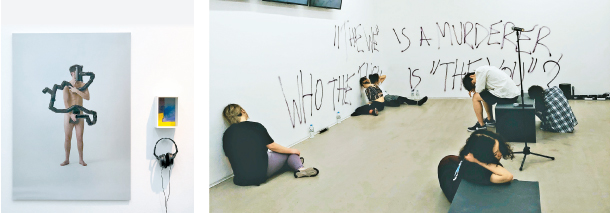At 'Dear Amazon,' artists confront humanity's influence on nature

Left: Gui Ponde’s “The Otherness As A Game-Seoul” (2019) features photographs of people interacting with strange props, with audio explanations provided in the voice of SIRI. Performers put on anguished expressions during the “Your Life During WW3” performance by Marcel Darienzo. [ILMIN MUSEUM OF ART, KIM EUN-JIN]
This performance, titled “Your Life During WW3” by Marcel Darienzo, is one of many works that explore the interactions between humans and nature at “Dear Amazon: The Anthropocene 2019” at the Ilmin Museum of Art, central Seoul.
This thought-provoking exhibition captures life during the Anthropocene, defined as the current geological age during which humans wield a huge influence on the climate and environment.
“Dear Amazon” is mostly made up of works by artists from Brazil. Tackling mundane topics like housing, fishing and mineral exports, the artists highlight the points of collision between human activity and nature as their resource-rich country continues to develop - often, at the cost of the environment.
Minerals take the forefront in works by Mabe Bethonico and Joao GG. Bethonico’s “Extraordinary Mineral Stories” (2017) is a lecture performance that centers around the protagonist “Mineral,” who becomes the object of exploration on Earth as well as from outer space. With “Unpolished Stone” (2019), a collection of 3D printed replicas of minerals from Brazil, GG proposes a creative distribution system that is both cost-effective and fuel-efficient.
Like Darienzo, Gui Ponde focuses on imagining the post-apocalypse with “The Otherness As A Game-Seoul” (2019). His installation features photographs of bodies interacting with unusual props in isolation, intended to signify how humans in a post-apocalyptic world will no longer interact with other living species.
“Dear Amazon” offers plenty of hands-on activities for visitors to engage in as well. Alexandre Brandao’s “Court” (2013), for example, is a large installation inspired by “bocce,” a ball game popular in Brazil. Visitors are encouraged to make up their own rules as they roll charcoal balls onto a field of white sand.
At the “Lounge Project” on the third floor, equipped with mats, bean bags and a hammock, visitors can meditate and do yoga by following an instructional video on TV.
Organizers behind “Dear Amazon” added several interactive, if not obtrusive, elements to force visitors to get up close and personal with nature. For example, the museum’s elevator is filled up with tall potted plants, leaving just enough space for one person to get on. Outside the elevator, visitors are still obligated to share their space with nature as robotic cleaners carry more potted plants around the museum floor, almost as if the plants were observing the artworks alongside human visitors.
For cinema fans, the Presseum Theater on the museum’s fifth floor will be screening short films like Ana Vaz’s “A Idade da Pedra” (2013) and others that confront the clash between culture and nature. Videos have all been provided by the Videobrasil Historical Collection.
BY KIM EUN-JIN [kim.eunjin1@joongang.co.kr]
“Dear Amazon: The Anthropocene 2019” runs through Aug. 25. Tickets are priced at 7,000 won ($5.90). The Ilmin Museum of Art opens from 11 a.m. to 7 p.m. and is closed on Mondays. “Your Life During WW3” is only presented during Saturdays and Sundays at 2 p.m. For more information, call (02)-2020-2050 or visit ilmin.org










with the Korea JoongAng Daily
To write comments, please log in to one of the accounts.
Standards Board Policy (0/250자)